

ShowCase is an on-going feature series on Archinect, presenting exciting new work from designers representing all creative fields and all geographies.
We are always accepting nominations for upcoming ShowCase features - if you would like to suggest a project, please send us a message.
Structures of contemporary high-rise buildings, though often limited by material capacities, dynamic lateral forces, and legal constraints, have recently undergone a renaissance of investigation. The list of known structural types such as moment frames, braced frames, trussed tubes, and shear wall systems has been expanded to include new morphologies and materials including non-metric cellular formations, exoskeletal lattices, and next-generation carbon fiber composite networks.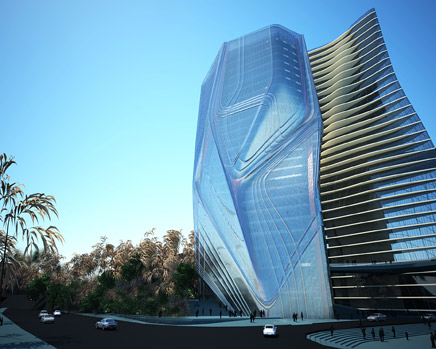
Huaxi Urban Centre Tower
Experimentation in the realm of mechanical systems, however, is far behind. Most high-rise buildings are still outfitted with a hidden and expensive network of metal ducts which are run through structural cores or between structural beams in an ineffectual and often conflictual way. Mechanical systems have become the ‘other’ of structure, relegated to dark inaccessible spaces, inevitably remaining architecturally inert. At one moment in recent history, however, architects began turning buildings inside-out for the sake of the expression of HVAC systems. That movement in architecture-- Structural Expressionism-- was nevertheless problematic from the start since projects effectively transported known HVAC systems wholesale to the exterior without any productive transformation in terms of form, organization, or atmosphere.
Huaxi Urban Centre Tower at night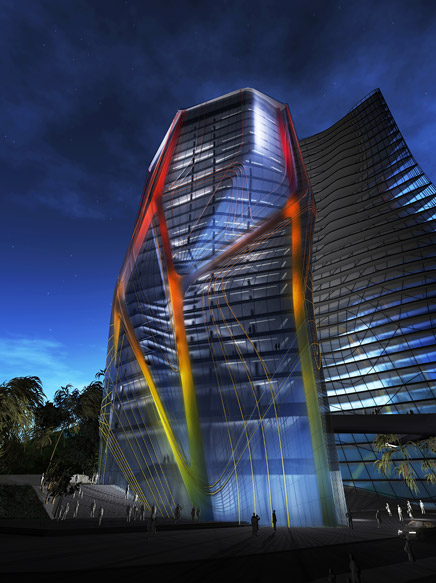
Huaxi Urban Centre Tower at night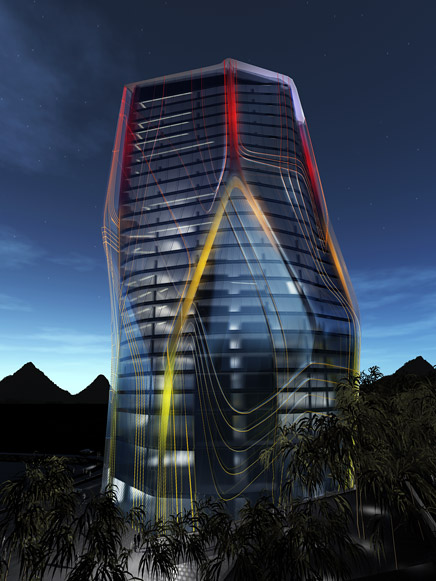
Huaxi Urban Centre Tower at night
This project revisits the problem of architecturalizing tower infrastructural systems. Rather than expressing the literal image of technology, the goal is to create technological ambience. This ambience is defined by translucency, shrouding, and exotic lighting and color effects. But it is also the result of hybridizing mechanical systems with other building systems in a way that cross-wires traditional hierarchies and produces synergetic forms.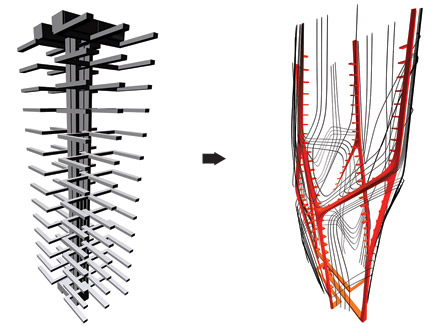
Conventional High Rise HVAC vs. Huaxi Urban Center Tower #7
The point of departure for the design was to allow ductwork to migrate out of the central core toward the exterior. The glass envelope begins to take on duct behavior by delaminating to create pleats where air can flow. These pleats branch and run across the building facades, linking to floor plenums on each level at several locations along the perimeter.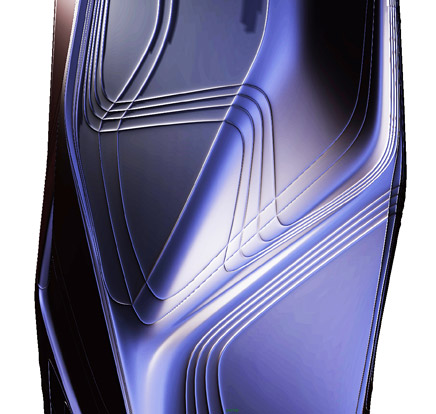
Huaxi Tower Pleat Study
A second layer of loose-fitting skin wraps the glass duct-skin, registering the pleats and shrouding the building. This shroud is made of perforated sheet metal. It acts as a sunscreen during the daytime, while nonetheless allowing views through.
At night, the glass ducts glow from behind the shroud, creating elegant color and depth effects, reflections, and silhouettes. Their freeform morphology and variegation begin to create associations with the lush natural terrain of the site.
EMERGENT
Founded in 1999 by Tom Wiscombe, EMERGENT is dedicated to researching issues of structure, tectonics, and materiality through built work. EMERGENT is a platform for experimentation, leveraging techniques and logics from fields outside architecture including biology, complexity science, aerospace engineering, and computation. EMERGENT’s directive is to move beyond categorical thinking in architecture and the stratification of building systems. This involves a re-examination of heirarchies and discreetness of systems toward coherent but differentiated constructions. Ultimately, the results are understood both in terms of performance and spatial and atmospheric effects.
EMERGENT’s approach is informed by contemporary models of biology and systems theory as well as by the arts, toward an architecture based on structural pattern formation and emergent behavior. The work is part of a larger contemporary movement in architecture referred to by Detlef Mertins in 2004 as ‘Bioconstructivism’, where a bias toward material intelligence begins to produce an architecture characterized by its variability and responsiveness to local forces.
The work questions the dialectic of excess and efficiency in architecture, in favor of a more complex understanding of both through biological thinking. The recursive process of random mutation and natural selection in nature provides a model for how a dynamic feedback between excesses and efficiencies can create innovation and elegance. This feedback logic is executed in the office using both generative and analytical algorithms as well as hands-on design techniques.
Key to the work is the phenomenon of emergence which offers insight into the way apparently isolated bodies, particles, or systems exhibit group behavior in coherent, but unexpected, patterns. The animated beauty of emergent organizations, such as in swarms or hives, points to a range of real architectural potentials where components are always linked and always exchanging information, and above all, where architectural wholes exceed the sum of their parts.
Biological thinking has led EMERGENT toward the exploration of new methods of systems integration, construction documentation, and fabrication. Recent co-ventures with international engineering companies, including Buro Happold and DeSimone Consulting Engineers, have begun to reveal new working methods which establish active feedback loops between engineering and design disciplines, ultimately pointing to a redefinition of AEC territories.
11 Comments
This is B.S., what has he ever built?
Tom Wiscombe was Senior Designer and Project Partner at Coop Himmelb(l)au for over 10 years, right-hand to Principal Wolf Prix. He was in charge of various internationally reknowned projects, including the Dresden UFA Cinema Palace, the Lyon Musée des Confluences, and the Akron Art Museum. Most notably, Wiscombe was Senior Designer for BMW World, Munich, which has been hailed as one of the most important buildings of the 21st century.
I have never heard EMERGENT associated with those projects. Was he a partener with Coop Himelb(l)au?
I'd be interested to hear in more depth how the system works rather than just that the building wears the HVAC system on its exterior which seems like a one-liner...
wasn't Tom just working at Coop Himelb(l)au as a project architect rather than the UFA being a partnership between Emergent and Coop? Emergent wasn't founded until 1999 as it says in the bio and the UFA was completed in 1998. splitting hairs but still...
The diagram of the HVAC is really compelling and the pleats are great. The argument that most buildings are "outfitted with a hidden and expensive network of metal ducts" is hard to bounce of considering this would be the most expensive mechanical duct ever (not to mention efficiency). That does not seem the right way to go to make a argument for this. By new methods of construction documentation you mean something like CATIA? I wonder if this will go past diagram phase because it would be nice to see a CATIA model.
Very Great Concept! What Software did he use for the pleats and organic shape ? Does anyone know ?
dude has emo hair, neat
maya, nice job josh.
wow. what a pumped credibility grab.
it would be more substantial if the time was spent on getting rid of mechanical systems all together.
this is more like a plumber cake.
Really nice images.
that dude is my instructor.. haha
Block this user
Are you sure you want to block this user and hide all related comments throughout the site?
Archinect
This is your first comment on Archinect. Your comment will be visible once approved.